Experiencing the New Perspectives of Ryukyuan Arts in South America Report on the Ryukyu-Okinawa Traditional Performing Arts Tour of South America
Daisuke Kato (Americas Section, Arts and Culture Dept.)
Both Bolivia and Brazil are countries that have deep connections with Okinawa Prefecture. In Bolivia, for instance, there is a town called Colonia Okinawa, a settlement of Okinawan migrants in Bolivia. It is a place where the culture of Okinawa is preserved and passed from generation to generation. The first Japanese settlers came to Colonia Okinawa some 60 years ago. The present project was planned and implemented in order to commemorate the 60th anniversary of the establishment of Colonia Okinawa and the 100th anniversary of Japan-Bolivian diplomatic relations. As Sao Paulo in Brazil is home to many people of Okinawan descent, and the year 2015 marks the 120th anniversary of the conclusion of the Treaty of Friendship, Commerce and Navigation between Japan and Brazil, the project was also carried out in Brazil.
The National Theatre Okinawa cooperated with the Japan Foundation in the organization of this project. The company is engaged in various initiatives to promote and preserve Okinawa's traditional performing arts, and in 2014 celebrated its 10th anniversary. Their schedule was packed with commemorative events, so it was a very busy period for them, but all involved parties, including the artistic director Michihiko Kakazu, recognized the significance of this project, and agreed to participate in it with 11 members, mainly young and currently popular performers of the group, who would present traditional Ryukyuan arts in Bolivia and Brazil.
On August 17, 2014, we gathered at Naha Airport early in the morning, at 6:15 a.m. All members of the group were not particularly well-traveled overseas, and the journey ahead of us was quite long: about 30 hours one way. An atmosphere of thinly-veiled nervous apprehension hung over the group. I was impressed with the fact that all of them had a bowl of Okinawa soba before departure as if to remind them of the taste of the homeland. After a long flight, we finally arrived in Sao Paulo. To my immense surprise, Mr. Satoru Saito, a young dance performer from Sao Paulo, came to meet us at the airport despite the fact that it was 5 a.m. Mr. Kakazu and Mr. Osamu Aka, one of the dancers, who had visited Sao Paulo two years earlier, were very happy to meet Mr. Saito again. The reunion surprised and delighted the rest of the group members as well.
As I already mentioned, Sao Paulo is home to a large Nikkei community, and sure enough, the venue was packed with many Nikkei and people originally from Okinawa Prefecture. Apparently, tickets for the event were all taken within an hour of release (!), proving the high level of interest in this project. Toward the end of the performance, the entire audience gave a warm standing ovation to the performers. The loud cheers touched them deeply. Dancer Yoshikazu Sanabe shared his emotional response, saying that he was happy and moved to tears. After the end of the performance, an elderly woman came to the reception desk requesting to meet one of the dancers, Mr. Shigeo Miyagi. It turned out that the woman was an acquaintance of Mr. Miyagi's relatives, and since that was probably her only chance to meet him, she just wanted to say hello. Her wish came true, and the woman went home with a happy smile. Such a wonderful encounter was possible precisely because of the large number of Nikkei and migrants from Okinawa Prefecture in Sao Paulo.
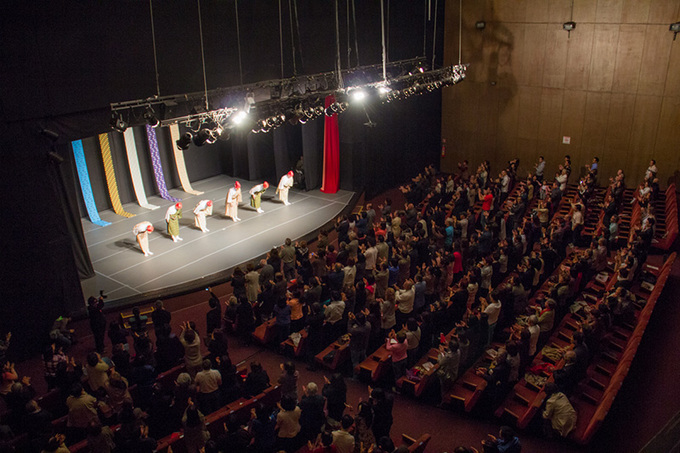
Standing ovation to the performers

Left: A long line at the entrance
Right: The audience dancing with the performers
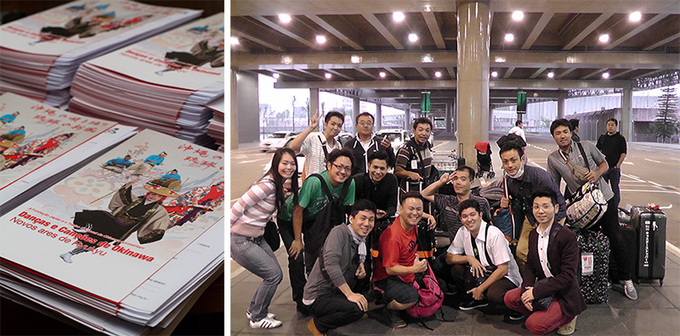
Left: Brochures of the performance
Right: The members of Ryukyu-Okinawa Traditional Performing Arts Tour upon arrival in Sao Paulo
Unlike Sao Paulo, Rio de Janeiro does not have such a large Nikkei community. The venue of the performance was Brazil's iconic theater Cidade Das Artes. Designed by French architect Christian de Portzamparc, the huge concrete building was a truly spectacular sight for the group members. They were not entirely sure how to draw a good response from the audience that knew almost nothing about Okinawa or Japan and did not understand the language. The performance in Rio de Janeiro was going to be an enormous challenge for them of the group. At the actual performance, however, the hall was completely full, and although the audience did not understand the language, they enjoyed and appreciated the comical gestures and graceful dances, which made them erupt into laughter, cheers, and applause. Like in Sao Paulo, toward the end of the performance, waves of standing ovation spread throughout the audience. The success in Rio de Janeiro was a great boost for the confidence and expectations of the cast as we headed to the next destination of the tour, Bolivia.
Rio de Janeiro was a great boost for the confidence and expectations of the cast as we headed to the next destination of the tour, Bolivia.
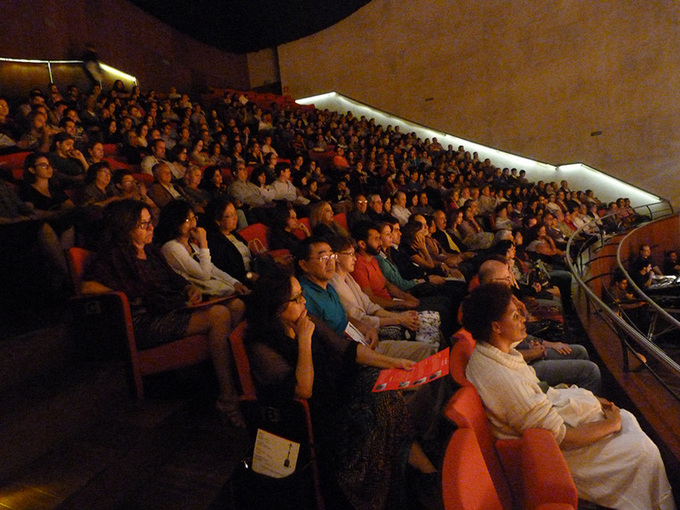
The enrapt audience
Bolivia
The group successfully completed their program in Brazil and traveled to Colonia Okinawa in Bolivia. A board with a sign "Welcome to Okinawa," written in the Okinawan dialect, greets visitors to the town. All members of the group reacted with great surprise to the sign and for a while could not put their cameras down. Unlike the busy and vibrant Sao Paulo or Rio de Janeiro, Colonia Okinawa is a quiet town with an abundant nature. The audience were composed mainly of elderly citizens and families, and the atmosphere was warm and mellow. At a workshop held at an elementary school, the performers provided guidance and instruction to students who were learning the sanshin, an Okinawan musical instrument, and Ryukyuan dance at school. The passionate and earnest attitude of the children impressed greatly chorus members and instructors at the workshop Itsuo Nakamura and Kazuki Tamashiro, and created a joyful and relaxed atmosphere.

Left: Interacting with an elderly member of the audience
Center: A performer dances with a father and his child
Right: Shaking hands with the audience after the performance

Left: Workshop implemented at an elementary school
Right: Performers provide instruction to students
Santa Cruz is a city with few residents of Japanese descent. The performance there was held at a venue with seating for 400 people. Some members expressed apprehension whether the seats would be filled. In order to boost the publicity of the performance in Santa Cruz, we had arranged for a TV appearance. For the performers, this was the first appearance on live TV overseas, so naturally they were filled with nervous excitement. The program presenter took a great liking to dancer Satoru Arakaki and spoke to him in Spanish. Mr. Arakaki was utterly confused. This, however, was quite entertaining for the audience. The Bolivian staff members in the waiting room, too, laughed a lot. The program was very popular, so the group's appearance greatly boosted the publicity of the performance. A long line formed at the reception prior to the opening of the venue, and more than 600 people packed the 400-seat hall. The performance was a great success, with some audience had to stand. The organization, too, proceeded very smoothly thanks to the hard work of local students led by Yukimori Nikaido.

Left: Members of the audience dancing together with the performers
Right: Artistic director Michihiko Kakazu giving an interview
The final performance in the tour was held in La Paz. We had heard various things about La Paz even before departing. It is the capital of Bolivia, yet it is located high in the mountains, at an elevation of nearly 4,000m. We knew that there were many precedents of visitors of La Paz developing altitude sickness, and the group members could not hide their anxiety. Two days prior to our departure for La Paz, we started taking medication to prevent altitude sickness but we did not know whether the medication would have any effect, so we just prayed we would arrive and complete the performance safely. On the night of our arrival in La Paz, stage director Michiaki Nakamura, our unsung hero, developed a strong headache and could not sleep. He took some painkillers he had brought from Japan, and somehow managed to overcome the pain. The situation, however, demonstrated that the performers were true professionals. Despite the physical hardships, and the fact that they had to use oxygen tanks to breathe, they successfully completed the performance. Incidentally, the day of the performance in La Paz was Mr. Kakazu's birthday. The staff of the Japanese embassy in Bolivia prepared a cake and a surprise party for him. He was really surprised when the cake suddenly appeared. Immediately after the performance, many people from the audience gathered at the reception venue and sang "Happy Birthday" in English and Spanish. All members celebrated the final show of the tour, had some drinks although it was not advisable to drink alcohol at such a high altitude, and got a little red in the face with a sense of satisfaction.
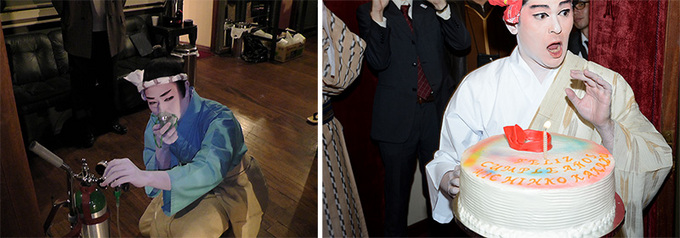
Left: A performer breathes using an oxygen tank during the performance
Right: Mr. Kakazu reacts with astonishment at the surprise birthday cake

Left: The comical performance got the audience excited
Right: A beautiful dance performance
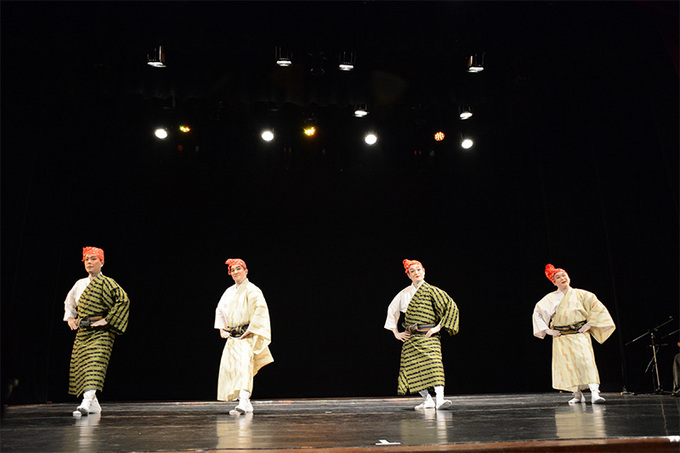
Overcoming altitude sickness, the performers successfully completed their final show
Every city on our tour in Brazil and Bolivia had distinctive characteristics, and the atmosphere at each performance was completely different. At each venue, however, the performers were warmly welcomed by a large audience. We sincerely hope that, through this project, a bright rainbow of friendship and exchange linked ever more strongly Brazil and Bolivia with Japan. (Incidentally, on the day of our return in Naha, a large rainbow appeared in the sky.)
Keywords
- Traditional Arts
- Performing Arts
- Music
- Brazil
- Bolivia
- Okinawa
- Colombia
- Sao Paulo
- National Theatre Okinawa
- Michihiko Kakazu
- Ryukyu
- Satoru Saito
- Osamu Aka
- Yoshikazu Sanabe
- Shigeo Miyagi
- Rio de Janeiro
- Cidade Das Artes
- Christian de Portzamparc
- sanshin
- Ryukyuan dance
- chorus
- Itsuo Nakamura
- Kazuki Tamashiro
- Santa Cruz
- La Paz
Back Issues
- 2025.9.30 The 51st Japan Found…
- 2025.9.30 The Japan Foundation…
- 2025.9.30 Bringing the World C…
- 2025.9.30 The 51st (2024) Japa…
- 2025.9.30 Japan Foundation Pri…
- 2024.5.24 The 50th Japan Found…
- 2024.3. 4 Movie Theaters aroun…
- 2023.4.10 The 49th Japan Found…
- 2023.3.28 JF's Initiatives for…
- 2023.1.27 Living Together with…

